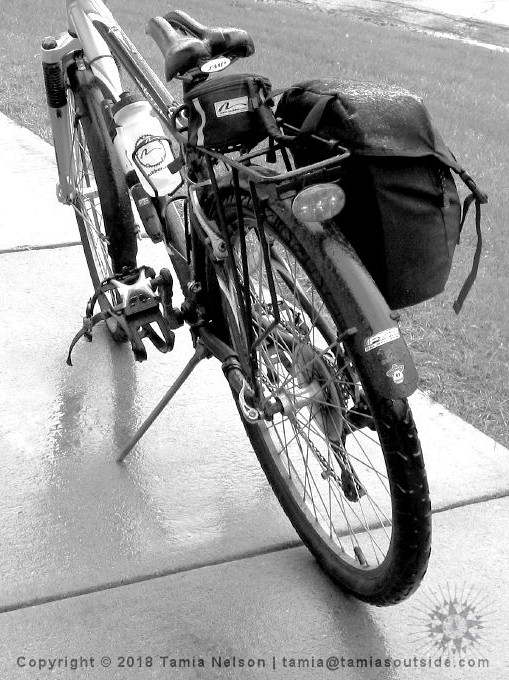Cheap fenders might not win you any style points, but they’ll help both you and your bike stay clean in foul weather. And guess which is more important.
______________________________
by Tamia Nelson | March 31, 2018
![]()
There are a few places on earth where bicycles are considered basic transportation, and in those places, it’s rare to find a bike without fenders. (The Brits call these vital accessories “mudguards,” and that’s a far more descriptive term, but since I’m writing on a US passport, I’ll stick to “fenders.”) The reason why anyone would want fenders on a bike is obvious to anyone who’s ever cycled on wet roads without them. Hint: The soggy, gritty, black stripe up the back from rump to shoulders is a giveaway.
Having said this, fenders are uncommon on bikes here in the States. Few roadies would mount them on their bikes, even if the frames were designed to accommodate fenders. You might think that touring bikes would be built with them, but you won’t find many that are built with fenders as a matter of course. A case in point: The owner of a new “complete build” Surly Long Haul Trucker wrote to me for advice. LHTs don’t come with fenders, and the dealer from whom she bought her bike didn’t stock them. The upshot? She was left to outfit her bike on her own. And she asked me for my recommendations on what to buy.
I had to admit that it’s not always easy to find serviceable fenders, especially if you’re pinching pennies. Many shops that stock fenders figure that their customers want a bit of bling to pimp their new rides, rather than just something to keep the water off their backs and out of their bottom brackets. So their shop stock runs to pricey sculptures in polished or hammered metal: good looking, to be sure, but often tricky to mount and prone to annoying rattles.
Nonetheless, there are inexpensive, workmanlike fenders to be found if you’re willing to look. First, though, you need to know these three things:
- Your bike’s wheel size, and…
- …the width of your tires (check the tire sidewall if you’re in any doubt).
- You’ll also want to know if your bike’s dropouts boast fender eyelets.
Long Haul Truckers’ dropouts are built with eyelets, I’m happy to say. And what if your dropouts don’t? Well, P-clamps can be used to fit fenders to an eyeletless bike, but they’re definitely a second-best solution.
Now, armed with a knowledge of your wheel size and tire width (write them down!), you’re ready to go shopping. If your local bike shop is a good one, they’ll have what you need, or they’ll be able to get it in just a few days. But if you don’t have a local shop, or if the owner has a hissy fit when you ask —it’s happened to me — then you’ll have to hit the information superhighway to find a more obliging retailer online.
You want full fenders, by the way. Shorties look cool, and if you ride a full suspension mountain bike you may have no choice but to buy short, but I’m afraid that diminutive blades won’t do much to keep you or your drivetrain clean. And that’s what fenders are for, after all.
Don’t assume that you’ll have to pay a fortune to get full coverage, by the way. A fender isn’t a high-tech gadget. If you stay away from the polished metal ornaments, you can splashproof your bike on the cheap. I’ve picked up perfectly satisfactory pairs of plastic fenders for USD20 — I don’t think we’ve ever paid more than USD35 — and they’re still going strong after a decade and many thousands of miles, not to mention a few crashes.
Brand names? OK. Farwell’s Trucker sports 60-mm-wide Planet Bike Hardcores, while his winter bike wears a similar pair of Zefals, as do both of my bikes. All of these are plastic — polycarbonate, in fact — and while they don’t polish up worth a damn, no pair has even given us any cause for complaint, though we did outfit the front fenders on two of our bikes with long mudflaps cut from soda bottles. We were hoping to improve their coverage down at bottom-bracket level, and our hopes were realized.
The bottom line? Fenders may not raise your street cred with fixie-obsessed hipsters, but they’ll make cycling a lot more attractive when its wet or cold — or both — and they’ll cut down on the wear and tear on your drivetrain, too. (You’d be amazed at what your wheels throw up in the way of grit and salt. Or maybe you wouldn’t.) Anyway, wet and cold describes a whole lot of the year in these parts. If we only rode on smiling, summery days, we’d do a lot more waiting than riding. And what would be the fun in that?
Read more: Fenders Plus Mudflaps are Better | Cleaning Your Bike

